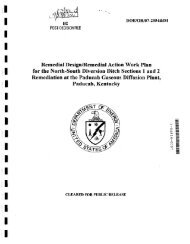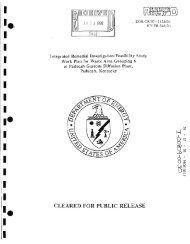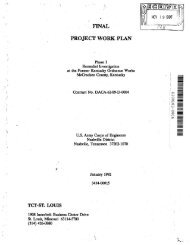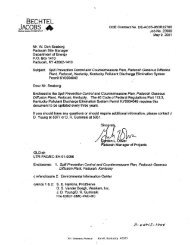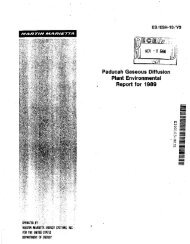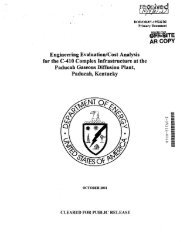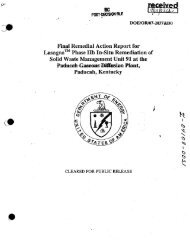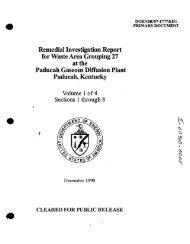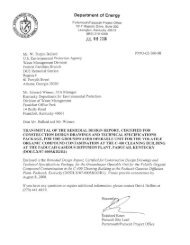1 - paducah environmental information center
1 - paducah environmental information center
1 - paducah environmental information center
You also want an ePaper? Increase the reach of your titles
YUMPU automatically turns print PDFs into web optimized ePapers that Google loves.
Annual Site Environmental Report for 1999<br />
surface and subsurface soils at WAG 28 are<br />
metals. This contrasts with the overwhelming<br />
and well-documented contamination in RGA<br />
and McNairy groundwater that is characterized<br />
by the presence of chlorinated alkenes and<br />
radionuclides (predominantly TCE and 99'fc,<br />
respectively). These. differences in the suites<br />
between the soil and groundwater-borne<br />
contaminants suggest that the areas investigated<br />
during the WAG 28 RIare not significant<br />
sources of the existing groundwater<br />
contamination. However, a range of<br />
contaminants, including metals, volatile organic<br />
compounds, and radionuclides, was detected in<br />
the soils at WAG 28, some of which appear to<br />
have the capacity to migrate to groundwater in<br />
the future.<br />
SWMV 99 does not contain significant<br />
contaminant concentrations in either the VCRS<br />
soils or VCRS groundwater that would suggest<br />
the site is currently or will in the future become<br />
a significant contributor of contaminants to the<br />
Northeast Plume. However, elevated levels of<br />
radionuclides were discovered in shallow soils<br />
surrounding a broken drainpipe that drains the<br />
SWMV 99 area. This migration pathway, which<br />
feeds Outfall 010, may be a contributing source<br />
to contamination observed in· the Northeast<br />
Plume in the underlying RGA.<br />
Sampling of the VCRS soils during the<br />
WAG 28 RI indicates that the primary source of<br />
the contamination in the RGAgroundwater at<br />
SWMV 193 does not exist at the former location<br />
of the Millwright Shop as originally believed.<br />
Moreover, TCE concentrations currently in the<br />
RGAgroundwater beneath the site have<br />
decreased significantly during the last four<br />
years. This decrease in TCE concentrations in<br />
the RGA ,at ,the Millwright Shop is best attributed<br />
to migration and dispersion of ,the contaminated<br />
groundwater plume.<br />
. At AOC 204, relatively minor<br />
trichloroethene concentrations « 100 Ilg/kg)<br />
weteobserved in the near surface soils adjacent<br />
to Outfall ,011, but higher concentrations were<br />
observed .at· greater . depths . in the· borings located<br />
in the interior of the site. This evidence indicates<br />
that contaminants detected in the VCRS soils are<br />
related to the downward percolation of surface<br />
water flow in Outfall OIl. This infiltration of<br />
contaminants from a losing surface water stream<br />
would appear to represent one potential. source<br />
for the contaminants present in the Northeast<br />
Plume.<br />
The results of the WAG 28 RI show that<br />
widespread contamination is not present in<br />
either the VCRS soil or the VCRS groundwater at<br />
any of the areas investigated. None of the WAG<br />
28 sites sampled for the RI has been identified as<br />
a significant contributor of contaminants to the<br />
underlying RGA groundwater. This conclusion<br />
is based on the evaluation of the nature, extent,<br />
and concentration of contaminants found during<br />
the WAG 28 investigation, taking into account<br />
the data obtained from both previous and current<br />
rounds of sampling.<br />
The Remedial Investigation Report for<br />
Waste Area Grouping 28 at the Paducah<br />
Gaseous Diffusion Plant, Paducah, KentuckY.<br />
(DOE 2000a) provides conclusions and<br />
additional <strong>information</strong> on the WAG 28 RI<br />
activities.<br />
WAGS<br />
In 1999, the WAG 8 SE was initiated with<br />
90% of the work being completed at the year's<br />
end. The goals of the WAG 8 SE were to confirm<br />
or deny the presence of contaminants at each of<br />
the WAG 8 sites, evaluate migration pathways to<br />
determine if the sites are presently sources of offsite<br />
contamination, and to determine risk from<br />
each site to on~site receptors. The focus of the SE<br />
was . to collect sufficient <strong>information</strong>. .about<br />
surface water, surface soil, subsurface soil, and<br />
shallow groundwater contamination to support<br />
the evaluation process. The results of the SE<br />
were· used to formulate recommendations<br />
concerning further actions for each site.<br />
Environmental .Program : Information<br />
3-9



